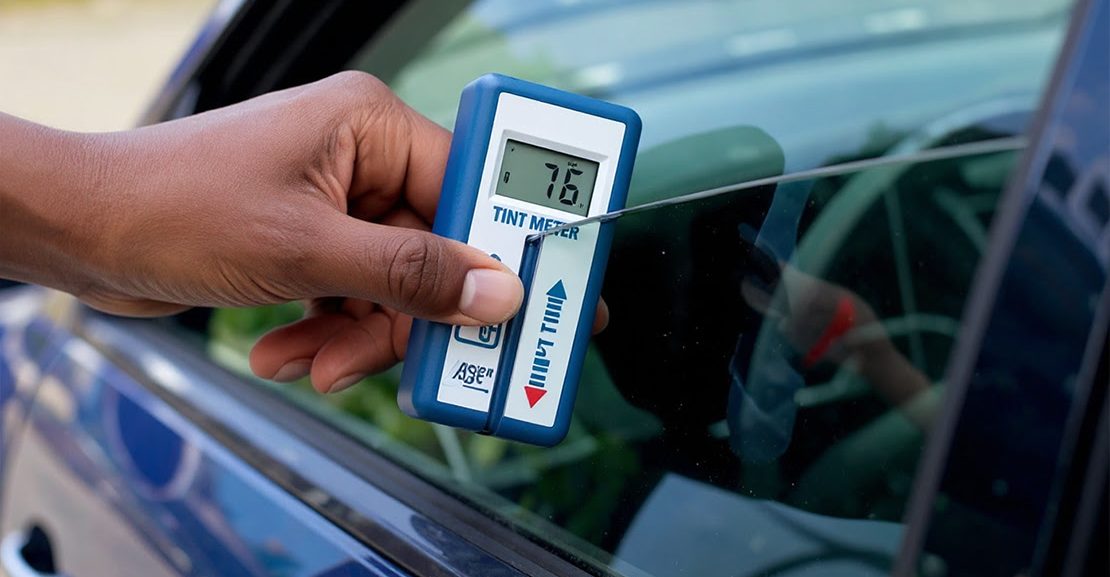The second that a police officer walks back to their patrol car and returns with a tint meter is when most drivers realize they have a problem. Maybe you bought your car used and it came with the tint already on it, or maybe you had it installed years ago and never had any issues before this.
California says that you need 70% visible light transmission on the front side windows, and plenty of drivers have no idea that their windows are technically illegal. The officer holds that little device against your window, and it measures how much light can pass through the glass. If the reading shows anything below 70%, you’re probably going to get a citation. These tickets start at just $25, but they can quickly grow to hundreds of dollars with fix-it requirements and extra fees.
The testing process itself is fairly simple, though the officers follow specific procedures to get an accurate reading. I’ve seen these measurements get thrown out in court because of improper testing angles or environmental conditions. The display shows a percentage, and this number determines if you’re driving away with just a warning or with a ticket in hand.
Here’s how tint meter readings work during California traffic stops!
What You Need to Know About California Tint
California has some of the strictest window tint laws in the country, and for an understandable reason – visibility matters for safety. The front side windows on your car need to let at least 70% of visible light pass through, and it’s measured as VLT or visible light transmission. A lot of drivers get confused about what this number actually means, and I see the results of that confusion all the time.
70% of the light has to get through the window – it’s what the 70% VLT requirement specifies – not that the tint blocks 70% of the light. It’s a common mistake that causes plenty of violations because drivers believe they have legal tint when they actually don’t. The percentage tells you how much light passes through – not how much it gets blocked. Higher percentages mean lighter tint and more light transmission.
The laws for your back windows and rear windshield are very different, though. California doesn’t limit these windows at all – they can be as dark as you want them to be. This leads to a strange situation where the front half and the back half of your car can look very different. Lots of drivers believe that all their windows follow the same laws, and that’s how they get illegal front tint without even realizing it.
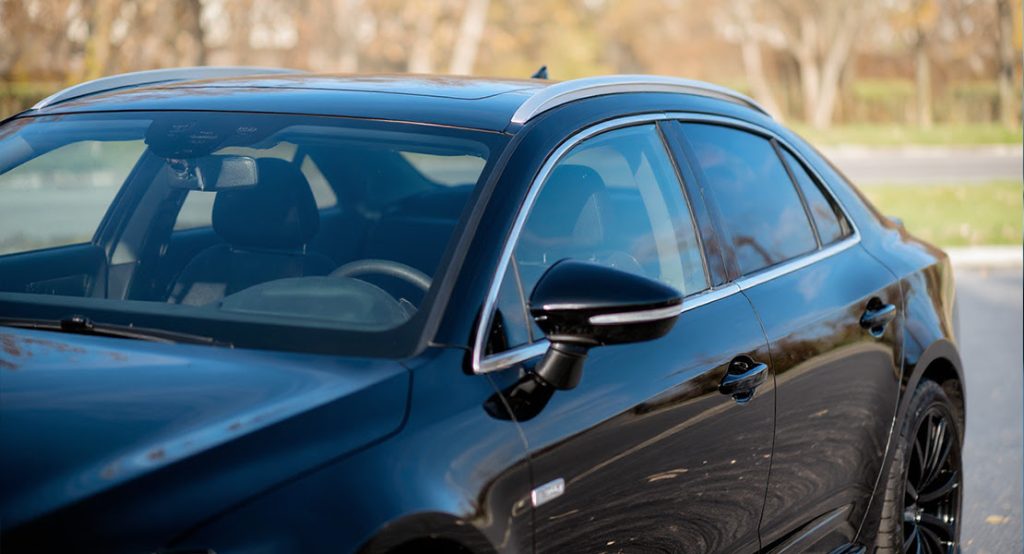
Drive over to Arizona or Nevada, and you’ll see a way darker tint on cars everywhere. Those states allow much lower VLT percentages on their front windows, and it’s great for their residents. The problem is that once you cross back into California, that same tint is illegal. Where you are doesn’t matter – the laws apply to your car, no matter where you bought it or where it was tinted.
Most new cars have some level of factory tint already installed, usually somewhere around 80 to 85% VLT. The tough part is that any aftermarket film gets added on top of that factory tint, and the percentages multiply together instead of just adding up. Even a fairly light aftermarket tint can push your windows below the legal limit once you factor in what was already there. The math starts working against you pretty fast with layered tints, and that’s usually when drivers run into problems.
How Police Use Tint Meters
A tint meter is really just a small handheld device that has two parts, and these parts clamp together with your car window right in the middle. The device works like a sandwich where the glass sits between two pieces of equipment. One side of the device contains a light source, and on the opposite side, there’s a sensor that measures how much light manages to pass through to the other side. The device then calculates the exact percentage of light that actually makes it through your window tint, and this percentage is what determines if your tint is legal or not.
Most police departments in California have switched over to the digital models at this point, and these show the measurement right there on a small LCD screen. The older analog versions are still floating around in some departments, though they’re on their way out. What most drivers don’t know is that these meters need routine calibration to maintain their accuracy. Police departments are responsible for maintaining their equipment, and they have to maintain careful records of every time they test and adjust these devices. This documentation matters quite a bit when challenging a tint ticket in court. A meter that hasn’t been correctly calibrated won’t stand up as valid evidence, and the ticket could get thrown out.
Officers don’t grab these devices and start testing windows randomly either. Every department puts its officers through specific training on how to use the tint meters. Part of that training includes testing the glass only when it’s completely dry and clean, because any moisture or dirt on the window can throw off the readings and give false results. Officers are also trained to check multiple places across the same window because the factory tint or aftermarket film can sometimes change in darkness from one area to another.
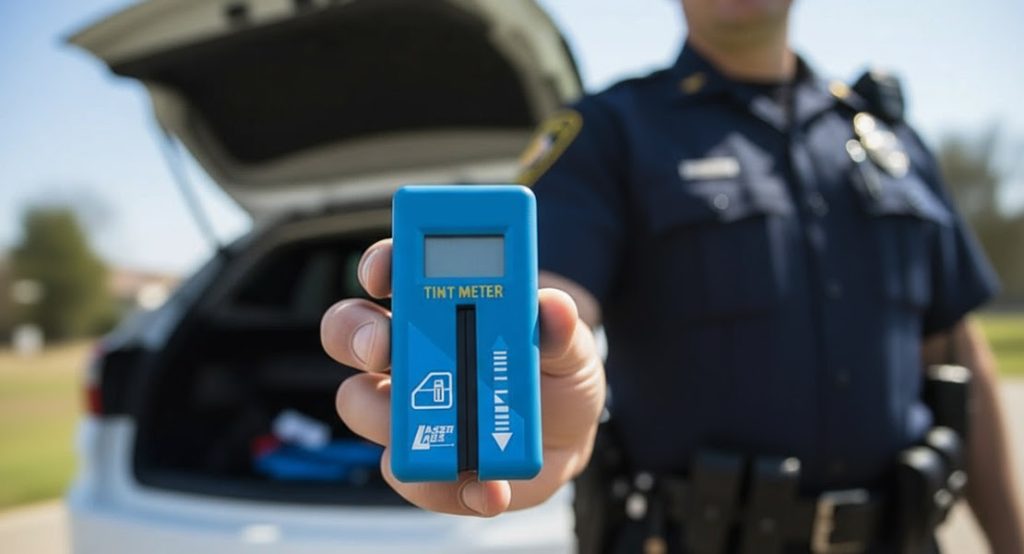
The companies that dominate the market are Enforcer and Laser Labs, and their digital models are what you’ll see in most patrol cars. These particular devices can display readings all the way down to the tenth of a percent, so officers are able to get extremely precise measurements of your tint levels. Many of the newer models also have built-in memory storage, which lets the officer take readings from a few different test points on your windows and document them for their report.
At the end of the day, the accuracy of any tint meter depends on two factors – whether it’s being used correctly and whether it’s been maintained properly. A meter that’s overdue for calibration could give you a reading that’s off by a few percentage points. The same goes for a meter that an officer uses on glass that’s still wet from rain or morning dew – those readings just aren’t going to be reliable.
How Officers Test the Window Tint
When an officer decides to check your window tint during a traffic stop, the procedure usually follows a pretty standard pattern. After the officer explains why they pulled you over in the first place, they’ll tell you they also want to test your window tint. At least this way, you know what’s coming and can mentally get ready for the whole process. The officer is going to need you to roll down your rear windows because they have to be able to access the inside surface of the glass with their tint meter.
For the testing procedure, the officer takes their meter and places it directly against your window glass at a few different places. Most officers start at the center of the window and then work their way out to test the corners and edges, too. The reason they check multiple places is that window tint can change quite a bit across a single window. Maybe the shop that installed it didn’t apply even pressure everywhere, or maybe the film stretched more in some parts than others during the installation. These variations happen all the time, and officers know to check for them.
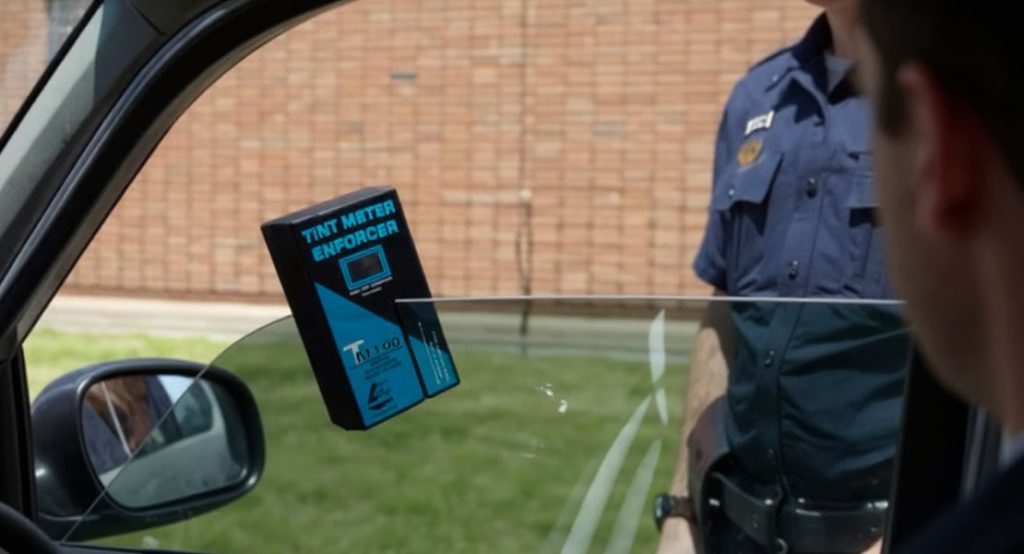
If your windows have any dust, smudges or fingerprints on them, a careful officer should wipe away the dirt before they take any readings. Dirt and grime can really affect what the meter shows, though the change isn’t always going to be in your favor, sadly. Some officers are very careful about this cleaning step, and others just test the window in whatever condition they find it.
The part that confuses drivers is how the final measurement gets determined. The officer records multiple readings from those different places on your window, and the lowest number they find is your official measurement. If most of your window measures at 75% light transmission, but one corner only reads 65%, that 65% is what goes on your ticket. It doesn’t matter that 90% of your window passes the legal limit if that one place fails.
Most officers will ask you to roll your window down a few inches for the tint test instead of keeping it closed all the way. The rubber seals and weatherstripping around your window frame mess with the meter’s accuracy, and they need a bit of space away from the frame to get a clean reading. It feels strange when the officer has to lean into your vehicle to position the device correctly on your glass. Just stay calm and let them finish the test – no need to move around or distract them as they work.
When Tint Meter Readings Can Be Wrong
Window tint tickets can usually be challenged in court, and there are actually a few different angles you can take to fight the measurement. The best first step is probably to ask for the calibration records for the officer’s tint meter right away. These devices have to be calibrated each year to stay accurate, and a lot of departments actually fall behind on keeping those certifications current. Without the right calibration at the time the officer tested your windows, that reading gets pretty questionable as evidence.
After you’ve requested those records, your next step is to visit a professional tint shop and have them take an independent measurement of your windows. Professional installers use professional-grade meters, and their readings sometimes come out very different from what the officer wrote on the citation. Save that receipt, and if possible, see if the technician would be willing to testify in court about their findings.
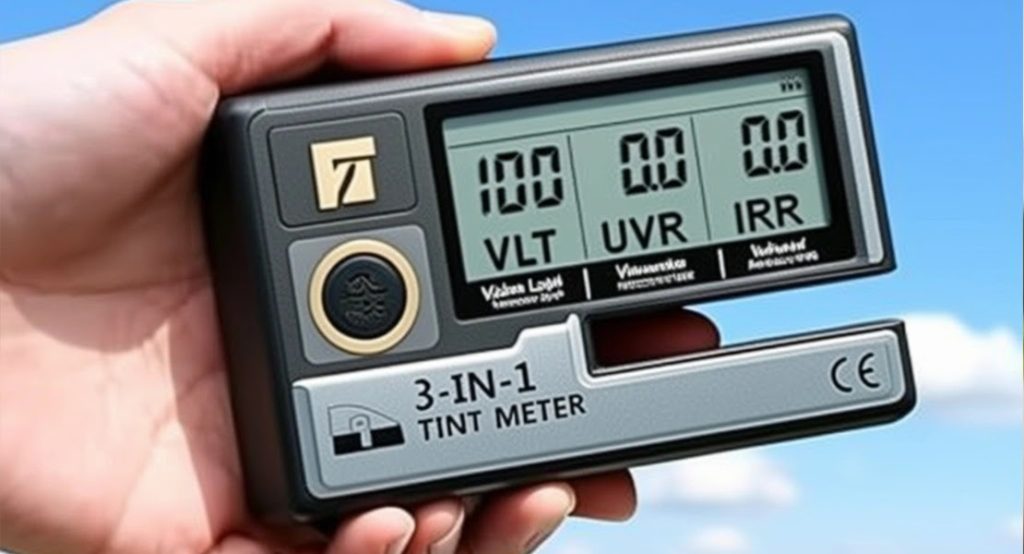
The conditions during your traffic stop can have a significant effect on the measurement. Extreme temperatures, either hot or cold, can affect how these meters read through the glass. The same goes for moisture – if it had just rained or if there was condensation on the windows, that could throw off the reading. A dirty window creates problems, too. Another common issue I see is officers who test the tint at the curved edges of windows since the glass there distorts the reading anyway.
Buying your vehicle used or from a dealership makes it worth checking if you have any factory tint. Head back to the dealership and ask for documentation about the original window specifications. Manufacturers usually install privacy glass that already meets all the legal standards, particularly on SUVs and trucks. The right paperwork from the dealer showing factory specs could get your case thrown out right away.
At some point, you’ll need to make a strategic choice – either remove the tint and request a dismissal or stand your ground and challenge the measurement itself. Either of these two strategies can work, though removal tends to get you a quicker resolution in most cases. Just make sure you document everything with photos before and after if you decide to remove the tint. Whichever path you take, save all your arguments and explanations for the courtroom – the side of the road during a traffic stop isn’t the place to debate the accuracy of the officer’s equipment.
Transform Your View with Professional Tinting
Once you’ve learned about tint meters and what goes on during traffic stops, you’ll feel a lot more confident if you ever see those red and blue lights behind you. It’s helpful to know what’s actually going to happen when you’re pulled over and an officer walks over to test your windows with that little device.
The percentage numbers that show up on the tint meter display control whether you drive away with just a warning or if you end up with a citation that stays with you for months afterward. The smartest drivers already know their tint percentages and have their paperwork ready long before they ever have to go through a traffic stop. Most California drivers have figured out a system that works fine for them – they make sure that their front windows stay within legal limits, and they add a darker tint to the back for privacy. This tends to keep both drivers and law enforcement satisfied.
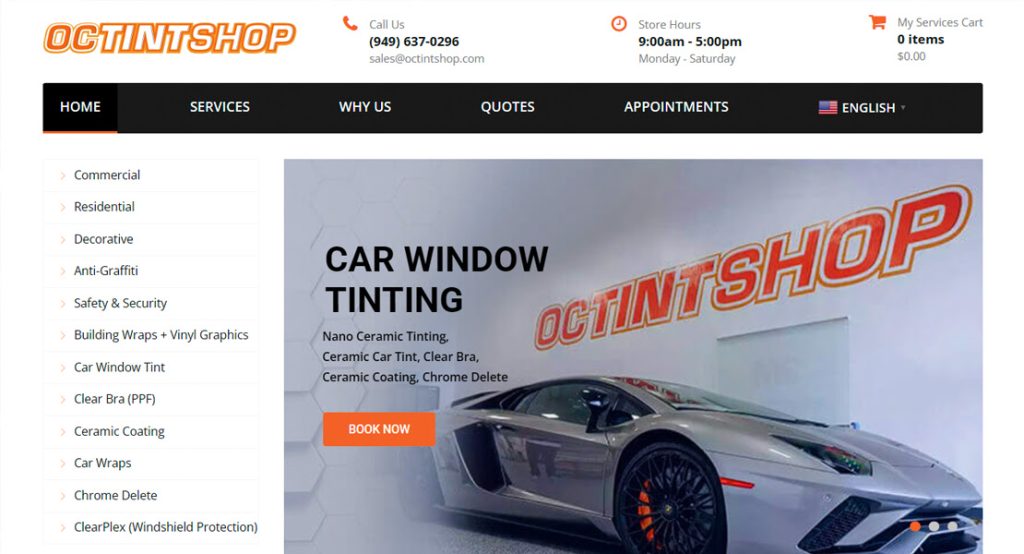
For window tint that looks great and stays legal, OC Tint Shop has been the trusted choice for Orange County drivers for years. We’ve installed thousands of window films that give our customers the exact look and privacy they want, and we always make sure that everything stays within California’s legal requirements.
Our shops in Newport Beach and Anaheim each use the same professional-grade meters that law enforcement uses, and we can verify and document your exact tint percentages right after the installation. Every customer walks out with proof of their legal tint levels, and this documentation gives them total confidence on the road.
Call us to set up your free consultation – we’ll show you all the options for window tint that work best for you!

